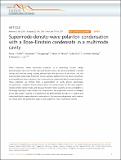Files in this item
Supermode-density-wave-polariton condensation with a Bose-Einstein condensate in a multimode cavity
Item metadata
| dc.contributor.author | Kollár, Alicia J. | |
| dc.contributor.author | Papageorge, Alexander T. | |
| dc.contributor.author | Vaidya, Varun D. | |
| dc.contributor.author | Guo, Yudan | |
| dc.contributor.author | Keeling, Jonathan | |
| dc.contributor.author | Lev, Benjamin L. | |
| dc.date.accessioned | 2017-02-17T15:30:17Z | |
| dc.date.available | 2017-02-17T15:30:17Z | |
| dc.date.issued | 2017-02-17 | |
| dc.identifier | 248507001 | |
| dc.identifier | 2f92c666-2f23-4446-82a3-f3dca04d29be | |
| dc.identifier | 85013223112 | |
| dc.identifier | 000394242900001 | |
| dc.identifier.citation | Kollár , A J , Papageorge , A T , Vaidya , V D , Guo , Y , Keeling , J & Lev , B L 2017 , ' Supermode-density-wave-polariton condensation with a Bose-Einstein condensate in a multimode cavity ' , Nature Communications , vol. 8 , 14386 . https://doi.org/10.1038/ncomms14386 | en |
| dc.identifier.issn | 2041-1723 | |
| dc.identifier.other | ArXiv: http://arxiv.org/abs/1606.04127v1 | |
| dc.identifier.other | ORCID: /0000-0002-4283-552X/work/30518212 | |
| dc.identifier.uri | https://hdl.handle.net/10023/10316 | |
| dc.description | Funding was provided by the Army Research Office. B.L.L. acknowledges support from the David and Lucille Packard Foundation, and A.J.K. and A.T.P. acknowledge support the NDSEG fellowship program. J.K. acknowledges support from EPSRC program "TOPNES" (EP/I031014/1) and from the Leverhulme Trust (IAF-2014-025). | en |
| dc.description.abstract | Phase transitions, where observable properties of a many-body system change discontinuously, can occur in both open and closed systems. By placing cold atoms in optical cavities and inducing strong coupling between light and excitations of the atoms, one can experimentally study phase transitions of open quantum systems. Here we observe and study a non-equilibrium phase transition, the condensation of supermode-density-wave polaritons. These polaritons are formed from a superposition of cavity photon eigenmodes (a supermode), coupled to atomic density waves of a quantum gas. As the cavity supports multiple photon spatial modes and because the light–matter coupling can be comparable to the energy splitting of these modes, the composition of the supermode polariton is changed by the light–matter coupling on condensation. By demonstrating the ability to observe and understand density-wave-polariton condensation in the few-mode-degenerate cavity regime, our results show the potential to study similar questions in fully multimode cavities. | |
| dc.format.extent | 10 | |
| dc.format.extent | 1870659 | |
| dc.language.iso | eng | |
| dc.relation.ispartof | Nature Communications | en |
| dc.subject | QC Physics | en |
| dc.subject | DAS | en |
| dc.subject | BDC | en |
| dc.subject.lcc | QC | en |
| dc.title | Supermode-density-wave-polariton condensation with a Bose-Einstein condensate in a multimode cavity | en |
| dc.type | Journal article | en |
| dc.contributor.sponsor | The Leverhulme Trust | en |
| dc.contributor.sponsor | EPSRC | en |
| dc.contributor.institution | University of St Andrews. School of Physics and Astronomy | en |
| dc.contributor.institution | University of St Andrews. Condensed Matter Physics | en |
| dc.identifier.doi | 10.1038/ncomms14386 | |
| dc.description.status | Peer reviewed | en |
| dc.identifier.grantnumber | IAF-2014-025 | en |
| dc.identifier.grantnumber | EP/I031014/1 | en |
This item appears in the following Collection(s)
Items in the St Andrews Research Repository are protected by copyright, with all rights reserved, unless otherwise indicated.

